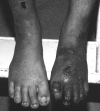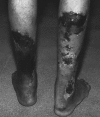Eosinophilic vasculitis: time for recognition of a new entity?
- PMID: 25332610
- PMCID: PMC4192264
- DOI: 10.1007/s12288-014-0384-2
Eosinophilic vasculitis: time for recognition of a new entity?
Abstract
Hypereosinophilia is part of a group of complex disorders with multisystem involvement. A 23 year old male was admitted to our centre with bilateral popliteal artery and venous thrombosis and impending gangrene of the left forefoot along with deep venous thrombosis of the right lower extremity. Investigations revealed marked peripheral blood eosinophilia (27,669/μL). Bone marrow showed increased eosinophils & eosinophil precursors and no evidence of a clonal disorder. Skin biopsy from the ulcerated lesions showed small vessel vasculitis with intense eosinophilic infiltration. Investigations to look for secondary causes of hypereosinophilia in the form of Antinuclear Antibody, P-Anti Neutrophil Cytoplasmic Antibody (ANCA) and C-ANCA and FIP1L1-PDGFRA, Bcr-Abl and JAK2V617F mutations were negative. The arterial and venous thrombosis and cutaneous vasculitis were linked to the presence of hypereosinophilic syndrome. The patient's illness responded to high dose corticosteroids leading to complete resolution of symptoms. We reviewed the literature on the lesser known entity of eosinophilic vasculitis and its association with thrombosis.
Keywords: Eosinophilia; Thrombosis; Vasculitis.
Figures




Similar articles
-
"Idiopathic Eosinophilic Vasculitis": Another Side of Hypereosinophilic Syndrome? A Comprehensive Analysis of 117 Cases in Asthma-Free Patients.J Allergy Clin Immunol Pract. 2020 Apr;8(4):1329-1340.e3. doi: 10.1016/j.jaip.2019.12.011. Epub 2019 Dec 18. J Allergy Clin Immunol Pract. 2020. PMID: 31863912
-
FIP1L1-PDGFRA Clonal Hypereosinophilic Syndrome With Eosinophilic Myocarditis and Intracardiac Thrombus.Cureus. 2023 Aug 8;15(8):e43138. doi: 10.7759/cureus.43138. eCollection 2023 Aug. Cureus. 2023. PMID: 37692703 Free PMC article.
-
Hypereosinophilia presenting as eosinophilic vasculitis and multiple peripheral artery occlusions without organ involvement.J Korean Med Sci. 2005 Aug;20(4):677-9. doi: 10.3346/jkms.2005.20.4.677. J Korean Med Sci. 2005. PMID: 16100465 Free PMC article.
-
A young female presenting with heart failure secondary to eosinophilic myocarditis: a case report and review of the literature.BMC Res Notes. 2018 Mar 9;11(1):168. doi: 10.1186/s13104-018-3273-1. BMC Res Notes. 2018. PMID: 29523179 Free PMC article. Review.
-
Cutaneous Manifestations of ANCA-Associated Small Vessels Vasculitis.Clin Rev Allergy Immunol. 2017 Dec;53(3):428-438. doi: 10.1007/s12016-017-8616-5. Clin Rev Allergy Immunol. 2017. PMID: 28578472 Review.
Cited by
-
Hypereosinophilia in a Young Patient: Occam's Razor or Hickam's Dictum?Indian J Hematol Blood Transfus. 2016 Jun;32(Suppl 1):340-3. doi: 10.1007/s12288-014-0487-9. Epub 2014 Dec 24. Indian J Hematol Blood Transfus. 2016. PMID: 27408431 Free PMC article.
-
Skin-limited idiopathic hypereosinophilic syndrome presenting with retiform purpura.JAAD Case Rep. 2019 Aug 7;5(8):742-745. doi: 10.1016/j.jdcr.2019.06.013. eCollection 2019 Aug. JAAD Case Rep. 2019. PMID: 31453308 Free PMC article. No abstract available.
-
Hypereosinophilic vasculitis with Raynaud phenomenon presentation: a case report.Egypt Heart J. 2023 Oct 18;75(1):89. doi: 10.1186/s43044-023-00418-6. Egypt Heart J. 2023. PMID: 37851184 Free PMC article.
-
Finger necrosis with eosinophilia and symmetrical occlusion of the peripheral artery.Heart Asia. 2019 Jun 5;11(2):e011211. doi: 10.1136/heartasia-2019-011211. eCollection 2019. Heart Asia. 2019. PMID: 31244917 Free PMC article.
-
Hypereosinophilic vasculitis: A case report.Medicine (Baltimore). 2019 Apr;98(17):e15392. doi: 10.1097/MD.0000000000015392. Medicine (Baltimore). 2019. PMID: 31027135 Free PMC article.
References
-
- Liao YH, Su YW, Tsay W, Chiu HC. Association of cutaneous necrotizing eosinophilic vasculitis and deep vein thrombosis in hypereosinophilic syndrome. Arch Dermatol. 2005;141(8):1051–1053. - PubMed
Publication types
LinkOut - more resources
Full Text Sources
Other Literature Sources
Miscellaneous
